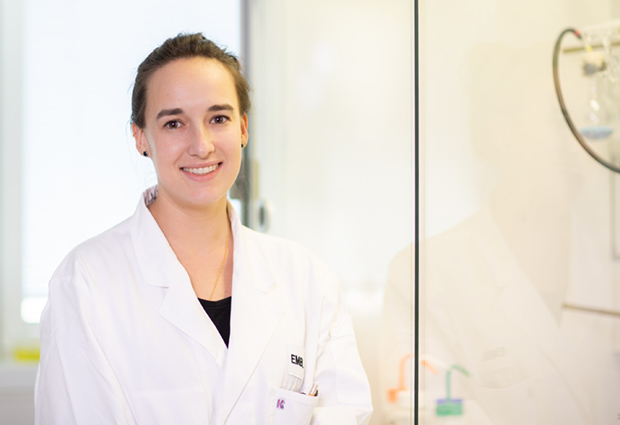
Welcome: Claire Deo
New group leader at EMBL Heidelberg employs synthetic chemistry to develop novel tools for biology

In her lab, Claire Deo develops fluorescent molecules that enable scientists to observe dynamic biological phenomena occurring at extremely small scales. Before joining EMBL Heidelberg, she worked at École Normale Supérieure Paris-Saclay and at the Howard Hughes Medical Institute in the US, where she designed novel biosensors to visualise calcium fluctuations in cells. Here, she shares insights into the research of her new group at EMBL and tells us what allows her to occasionally free her mind from science.
Tell us briefly about your scientific background.
I’m a synthetic chemist by training and have worked mainly in synthetic chemistry labs. During my postdoctoral training, I transitioned a little into the fields of biology and biochemistry. These experiences inspired me to use chemistry to design and engineer useful tools for biology.
What will be the focus of your lab’s research?
Our main focus initially will be on fluorescence microscopy, which is a very powerful tool for visualising biological phenomena. There is still a lack of robust molecular tools that are able to visualise highly dynamic events. Our goal is to design molecules that can respond to such demands. Fluorophores have been studied for more than a century, so there exists a lot of knowledge on how their structure affect their function. We start from existing fluorophores and try to improve their properties and design new functionalities. We then test their properties, go back to further improve them, and finally implement them in biological systems.
Can you give an example?
We’re currently developing molecules that can be applied in super-resolution microscopy. This requires the ability to turn them on and off in response to light. We design this property at the molecular level and combine it with approaches to label specific features in cells. These molecules can then be applied in biological systems to visualise processes that cannot be seen using conventional microscopy.
How can your work benefit from EMBL’s multidisciplinary environment?
EMBL is a perfect environment to do this type of research. When you develop tools for biologists, it’s ideal to be surrounded by the biologists who are going to be using those tools. I think that places like EMBL, in which tool builders and tool users have an extremely high degree of daily interaction, can really push the science forward. There’s nothing more satisfying then developing something that can enable someone else’s science. Conversely, seeing our tools applied can help us to improve the molecules further.
What characteristics are you looking for when recruiting scientists to your group?
For doing synthetic chemistry, some background knowledge in chemistry is certainly necessary. But, more than technical expertise, I’m looking for people who are really interested in the science and who are highly motivated. I believe that if you’re passionate about what you do, you can learn anything. It’s very important to me that people are self-driven and really enjoy doing science. Apart from that, it’s helpful to have a certain level of resilience in science, because you’re certainly going to face failure and criticism. Being able to move forward and build on this is an important skill.
Do you have any advice for young scientists who are thinking about starting their own group?
While going through the different steps of training and being a postdoc, I think you have to keep an open mind about the science that’s going on around you. I haven’t always done that, and I regret it a little bit today. It’s easy to get extremely focused on your own specific project. You lose sight of the bigger picture and get comfortable doing something that you’re familiar with. But I think it’s important to also take risks and try something new that you don’t know much about.
What are your favourite activities to free your mind from science for a while?
There are a few activities that allow me to have some mental space outside science. I enjoy running and try to run two or three times a week. As a side hobby, I do watercolour painting. This helps me to clear my head by doing something else. But I’ve actually found that developing creativity in manual, artistic activities promotes creativity in science, too. Both sides complement each other very well.


